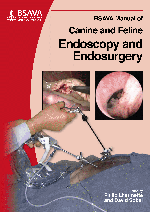
Full text loading...

PLEASE NOTE THAT A MORE RECENT EDITION OF THIS TITLE IS AVAILABLE IN THE LIBRARY
Nasal disease is common in the dog and cat, often presenting as a nasal discharge, with or without sneezing, stertor or stridor. Epistaxis may or may not be a feature, and can be present alone. Access to the rhinarium is difficult, since it is entirely encased in bone apart from at either end, and contains numerous turbinate scrolls forming many blind-ending channels in which foreign bodies or pathological changes can be hidden. There are only a limited number of direct physical approaches to the nasal cavity: dorsal rhinotomy; ventral rhinotomy; and rhinoscopy. Rhinoscopy is minimally invasive, providing reduced morbidity over other surgical options, and affords the best option for visualizing lesions and taking biopsy samples for diagnostic work, either for initial diagnosis or to confirm a suspected diagnosis. This chapter discusses Anatomical considerations; Indications; Preoperative diagnostic work-up; Intraoperative diagnostic work-up (under general anaesthesia); Instrumentation; Premedication and anaesthesia; Procedure; Caudal (posterior, retropharyngeal) rhinoscopy; Anterior (rostral) rhinoscopy; Frontal sinus exploration; Pathological conditions; Fungal rhinitis topical therapy; Postoperative care; and Complications.
Rigid endoscopy: rhinoscopy, Page 1 of 1
< Previous page | Next page > /docserver/preview/fulltext/10.22233/9781905319572/9781905319572.8-1.gif

Full text loading...


































